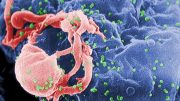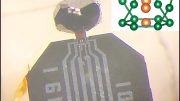
A research study by Tulane University discovered a new pathway for halting lung cancer. It highlights the role of RBM10 in suppressing cancer growth and identifies a mutant form that promotes tumors, paving the way for new treatments. Credit: SciTechDaily.com
The findings could lead to the development of a new anti-cancer drug and more personalized lung cancer treatment.
A new study by Tulane University has uncovered a previously unknown molecular pathway that could be instrumental to halting lung cancer in its tracks.
Lung cancer is one of the most common cancers and the leading cause of cancer-related deaths in the world. The research, published in the journal Proceedings of the National Academy of Sciences, could lead to the development of a new anti-cancer drug and more personalized lung cancer treatment, said senior study author Dr. Hua Lu, the Reynolds and Ryan Families Chair in Translational Cancer at the Tulane University School of Medicine.
RBM10 and Cancer Suppression
The study found that a known tumor suppressor protein called RBM10 can inhibit lung cancer growth by suppressing the function of c-Myc, a protein that drives cancer cell growth and proliferation when overexpressed. Researchers discovered that RBM10 partners with two ribosomal proteins (RPL5 and RPL11) to destabilize c-Myc and impede the spread of lung cancer.
These findings are the first to identify a cancer-inhibiting relationship between the proteins.
“We found that RBM10 can directly target c-Myc for degradation and reduce its cancer-causing effects by binding with RPL5 and RPL11,” Lu said. “We know a lot about cancer, but the molecules involved are still a black box. Piece by piece, we are gaining a better understanding.”
To understand how the process may work to halt the progression of lung cancer, imagine two factories in a cell, each manufacturing parts for assembly into new protein machineries; c-Myc plays a regular part in this protein production process — and cellular growth in general — and humans could not live without it.
Occasionally, this manufacturing is disrupted, and the factories begin producing incorrect parts. When cancer begins forming, it uses c-Myc to continue production, allowing these “spare parts” to accumulate and form tumors. RBM10, with the help of RPL5 and RPL11, can destabilize c-Myc and shut down tumor growth.
RBM10 Mutant in Cancer Progression
Importantly, the research also discovered that a mutant form of RBM10 often found in lung cancers loses the ability to suppress c-Myc, fails to bind to the RPL5 and RPL11 ribosomal proteins, and eventually promotes tumor growth instead of suppressing it.
“RBM10 is an important protein that can suppress cancer cells, but when a cancer wants to develop, it will mutate RBM10 and block that function,” Lu said.
Future Directions and Hope for Treatment
Lu hopes to further study how the RBM10 mutant functions in the hope of developing an anti-cancer drug to target it.
“Hopefully we can design a molecule to specifically target the mutant, since that’s a special structure not existing in the normal tissue,” Lu said. “If we can convert this mutant, we can hopefully make it suppress c-Myc’s cancer-causing activity.”
Reference: “RNA-binding motif protein 10 inactivates c-Myc by partnering with ribosomal proteins uL18 and uL5” by Hyemin Lee, Ji Hoon Jung, Hyun Min Ko, Heewon Park, Allyson M. Segall, Roger L. Sheffmaker, Jieqiong Wang, Wesley D. Frey, Nathan Pham, Yongbo Wang, Yiwei Zhang, James G. Jackson, Shelya X. Zeng and Hua Lu, 30 November 2023, Proceedings of the National Academy of Sciences.
DOI: 10.1073/pnas.2308292120









Be the first to comment on "Unlocking the Secret: How One Protein Can Halt Lung Cancer Spread"